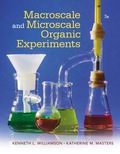
EBK MACROSCALE AND MICROSCALE ORGANIC E
7th Edition
ISBN: 8220101437488
Author: Williamson
Publisher: YUZU
expand_more
expand_more
format_list_bulleted
Question
Chapter 8, Problem 4Q
Interpretation Introduction
Interpretation:
The order from top to bottom for naphthalene, butyric acid, and phenylacetate spots developed on silica gel TLC plate should be determined.
Concept introduction:
TLC works on the principle of separation of constituents of a mixture of compounds based onpolarity. The polar compounds interact with the stationary phase. So, theycan move to smaller distance from the base,whereas, the non-polar compounds tend to move faster as they interact less with the silica gel.Therefore, they move far from the base of the plate.
Expert Solution & Answer
Want to see the full answer?
Check out a sample textbook solution
Students have asked these similar questions
1/2
-
51%
+ »
GAY
Organic Reactions Assignment
/26
Write the type of reaction that is occurring on the line provided then complete the reaction. Only include the
major products and any byproducts (e.g. H₂O) but no minor products. Please use either full structural
diagrams or the combination method shown in the lesson. Skeletal/line diagrams will not be accepted.
H3C
1.
2.
CH3
A
Acid
OH
Type of Reaction:
NH
Type of Reaction:
+ H₂O
Catalyst
+ HBr
3.
Type of Reaction:
H3C
4.
Type Reaction:
5. H3C
CH2 + H2O
OH
+
[0]
CH3
Type of Reaction:
6. OH
CH3
HO
CH3 +
Type of Reaction:
7.
Type of Reaction:
+ [H]
humbnai
Concentration Terms[1].pdf ox + New
Home
Edit
Sign in
Comment
Convert
Page
Fill & Sign
Protect
Tools
Batch
+WPS A
Free Trial
Share
Inter Concreting Concentration forms.
Hydrogen peroxide is
a powerful oxidizing agent
wed in concentrated solution in rocket fuels and
in dilute solution as a
hair bleach. An aqueous
sulation of H2O2 is 30% by mass and has
density of #liligime calculat the
Ⓒmolality
⑥mole fraction of
molarity.
20
9.
B. A sample of Commercial Concentrated hydrochloric
ET
If a reaction occurs, what would be the major products? Please include a detailed explanation as well as a drawing showing how the reaction occurs and what the final product is.
Chapter 8 Solutions
EBK MACROSCALE AND MICROSCALE ORGANIC E
Ch. 8 - Prob. 1QCh. 8 - Prob. 2QCh. 8 - What problem will ensue if the level of the...Ch. 8 - Prob. 4QCh. 8 - Prob. 5QCh. 8 - Arrange the following in order of increasing Rf...Ch. 8 - What will be the result of applying too much...Ch. 8 - Prob. 8QCh. 8 - Prob. 9QCh. 8 - A TLC plate showed two spots with Rf values of...
Knowledge Booster
Similar questions
- Would the following organic synthesis occur in one step? Add any missing products, required catalysts, inorganic reagents, and other important conditions. Please include a detailed explanation and drawings showing how the reaction may occur in one step.arrow_forward(a) Sketch the 'H NMR of the following chemical including the approximate chemical shifts, the multiplicity (splitting) of all signals and the integration (b) How many signals would you expect in the 13C NMR? CH3arrow_forwardDraw the Show the major and minor product(s) for the following reaction mechanisms for both reactions and show all resonance structures for any Explain why the major product is favoured? intermediates H-Brarrow_forward
- 3. Draw ALL THE POSSBILE PRODUCTS AND THE MECHANISMS WITH ALL RESONANCE STRUCTURES. Explain using the resonance structures why the major product(s) are formed over the minor product(s). H₂SO4, HONO CHarrow_forward7. Provide the product(s), starting material(s) and/or condition(s) required for the No mechanisms required. below reaction HO + H-I CI FO Br2, FeBr3 O I-Oarrow_forward6. Design the most efficient synthesis of the following product starting from phenot Provide the reaction conditions for each step (more than one step is required) and explain the selectivity of each reaction. NO MECHANISMS ARE REQUIRED. OH step(s) CIarrow_forward
- What is the skeletal structure of the product of the following organic reaction?arrow_forwardIf a reaction occurs, what would be the major products? Please include a detailed explanation as well as a drawing showing how the reaction occurs and what the final product is.arrow_forwardWhat is the major organic product of the following nucleophilic acyl substitution reaction of an acid chloride below?arrow_forward
arrow_back_ios
SEE MORE QUESTIONS
arrow_forward_ios
Recommended textbooks for you
 EBK A SMALL SCALE APPROACH TO ORGANIC LChemistryISBN:9781305446021Author:LampmanPublisher:CENGAGE LEARNING - CONSIGNMENT
EBK A SMALL SCALE APPROACH TO ORGANIC LChemistryISBN:9781305446021Author:LampmanPublisher:CENGAGE LEARNING - CONSIGNMENT

EBK A SMALL SCALE APPROACH TO ORGANIC L
Chemistry
ISBN:9781305446021
Author:Lampman
Publisher:CENGAGE LEARNING - CONSIGNMENT